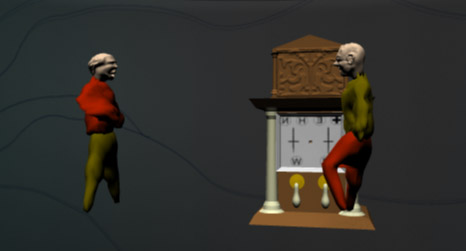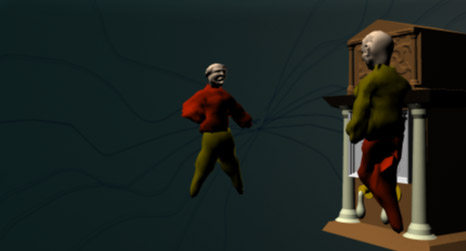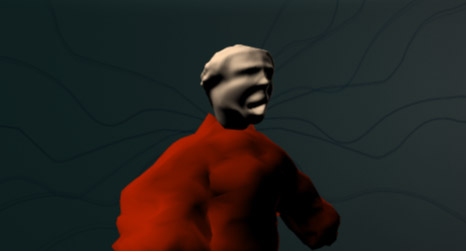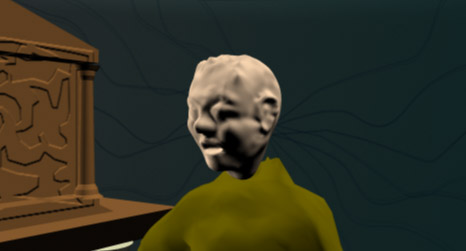 |
By Gregory Bringman
A Dialogue
Between d’Alembert and
Diderot.
Diderot: My earlier concern with animate and inanimate
matter, I would like to revisit with the notion of
virtual matter. Now as we are avatars in a computer-simulated
universe, engaging in a dialogue
in the manner of Fontenelle’s Dialogues of the Dead--beyond death,
preserved in computer simulation, I would like to think
that virtual matter is actual and potential at the
same time that it is a dynamics
of becoming.
d’Alembert: Right you are old friend. We are avatars, commanders
of a narrative unfolding before an audience of alternate
historians, who establish that there is a connection
between history retold and the
concept of matter, being, and becoming.
Diderot: Nevertheless, there are limits that I foresee,
such as on the transformation of human emotion into
electrical signals that share the brain’s conceits, explicitly—as
if this were desirable.
d’Alembert: Let us define “virtual”. We need an epistemology
that can account for impermanence in computing and outside of it. We
need an epistemology that will address the virtual nature of cognition
and how institutions and social facts external to speakers influence
those agents of language. For if the virtual is also the reflective ability
to “rethink” the facts, then all recording technologies,
writing, and computing, in recording temporal agent
positions in a sea of other temporalities, create the
phenomenon of erasing and redoing
common to life in simulation.
Diderot: Yes. We cannot conceive of the virtual without
some notion of the historical. The difference between epistemologies
of computing and epistemologies of the non-virtual world is in explicitness.
The agent, as in my writing on the blind, suppresses one sensory function
and this leads to expression in other sensory functions: the agent communicates
nevertheless in the virtual and the non-virtual, explicit and implicit,
actors explicitly recording experiences of the virtual world. Digital
services provide some differences between computers that allow infinite
recombinations of matter in the form of electricity, and between matter
proper. Recombining through larger micro-structures of historical writing--which
are, rather, both micro and macro, historians explicitly establish past
events in the present with more than just their memories.
d’Alembert: How do we in fact go from history writing to logic circuits?
And can we playfully reduce the gestures of cognition, that is, how we think
through feeling, to so many electrons crying, ‘I am great/I am non-existent’,
the 1s and 0s of binary code?
Diderot: Nice my friend. Your mathematical mind, computing rewards. Mathematics,
as the abbreviation of wholes, is a journey into abstraction. Ones and zeros
are the logic gates of materiality that are reified binary systems. History writing
has this in common with mathematics, the creation of worlds through local positions
of historical or mathematical agency. But keep in mind that the concept of techné and
human participation in the life of machines allows the writing of history and
furthermore, in coming back to the issue of virtual matter, or matter that is
potential and actual at the same time, of a history that is a story. The history
that is a story is an alternative reading, a virtual history. Like the progressively
neotnic organism who fake “cuteness” to gain an evolutionary advantage,
the history in story form, alternate form, proposes a distinction between what
happens in the narrative literally and the deeper historical values that structure
the narrative. Virtual history reads the artist sketch as the map of what could
have been, and when we speculate, what could have been becomes reality--exactly
in the way in which matter goes from inanimate to animate.
d’Alembert: I see, so history becomes animate, like the embodiment of a
text through a reader. What you suggest is that the writing of history is an
exemplification and actualization of matter. Or is it that there is a duality
between the tendency of atoms to stick together, that is, nature’s coding,
and the tendency of 1s and 0s to create the cipher, our cultural coding that
mimics the natural one.
Diderot: I make no distinction between nature and culture here. For nature encodes
and we recode. Nature always proposes a model that we realize; still our models
communicate nature in the only way it can be known--as culturally constructed,
that is mediated through texts and media. So nature’s coding is culture’s
coding. The computer mimics the pattern found in the metaphor of atomic deviation
and combination, where combination is constructive. Valence builds rather than
destroys. Everything is positive, in speech about nothing. There is no such experience
of anti-matter, except in death and only metaphorically in Boyle’s vacuum.
Not only does matter positively valorize itself, but it also creates the persistence
of the thinkable over the unthinkable--everything can be thought and this happens
as automatically as the deviation of the Epicureans.
d’Alembert: No distinction between nature and culture also adds the element
of the exemplification of matter through history writing in that it asks for
a particular understanding of the world. When we know in detail, part empirically,
part theoretically, we take responsibility for the past and the future. Why can
matter have a virtual dimension? It is because the units of matter are finer
than the finest linguistic act or linguistic particularization of the causes
of natural phenomena. The agent rethinks history. Matter is rearranged according
to acts of speech. We dynamically point to relational structures or highly differentiated
relations in the matter of the world. We say in particular how history means
what it means and how agents know not general laws, but particular knowledge
of natural science.
Diderot: Exactly. With the creation of stories for our histories, we construct
a particular art, one that seeks limits in order to become unbounded. It is a
paradox of an agent’s navigation of networks in society. This is the paradox,
that the agent is monadic yet connected. Still matter is exemplified and everything
can be thought, but not everything occurs to a body to be thought. Too, there
are objective mechanisms that ensure or prohibit the creation of animate history
from historical fact.
d’Alembert: I see. So the agent is constructively constructed and constructs
the relationships of the world in particular. The agent navigates in exposition
and in the writing of history, so that he or she may unmask particular relationships
that reconstruct discourse from the outside. Animate history is only possible
when there is a dialectical relationship between influencing and influenced,
although the subject has disappeared since the episteme turned into a rhizome.
Diderot: Exactly. Through an agent that influences as well as is influenced,
the universe moves on with the lives of other agents. She steps into the world,
taking a position; the world budges to accommodate her position. The other agents
in the system dynamically affect and are affected. But it is not simply people
who are outside of other people. Institutions pre-exist agents and create a backdrop
for the object, the text to be re-interpreted. Since cognition works along affecting
and affected lines, so too the object exists outside of the agent, although it
defines the agent in counterpoint.
d’Alembert: You could say that matter does not differentiate between subject
and object, although to those of us who can’t see our code in our bodies,
it differentiates between discursive production and the artifact of that discursive
production, the text (a code-like artifact).
Diderot: Yes. Matter is subliminal in a certain sense. We don’t see an
either/or of existence/non-existence. We perceive the world as qualities—qualitatively.
Although when we use virtual systems and when we also program them, matter has
an analog in the cipher. The cipher of computing also does not distinguish between
subject and object. And do we really? Or does the object socialize us into the
distinction between our bodies and the other?
d’Alembert: Yes, I see that way of looking at all of categorization and
classification as socialization into making distinctions between things. Thus,
does the recombination of matter reflect society? Is the social created through
the material?
Diderot: But the social is also created through the ephemeral and the virtual.
You have matter organized to encode information, and you have information organized
to encode our perception of qualities, and our perception of qualities encodes
our feelings and our existence.
d’Alembert: If it were not for this layering of the strata of encoding,
bodies would be mono-cellular and existence would have the complexity of only
the simplest components or of our simplified abstraction of a matter that is,
in fact, complex.
Diderot: And it is complex no doubt.
d’Alembert: Right you are old friend.
Diderot: Let us be inventors of animate history with practices that, if they
are reductions to 1s and 0s, they in turn counter the reductivity of the model,
from being so limited.
d’Alembert: Yes, let us, as agents, speak in particular of natural science.
Diderot: Yes, right you are old friend.
|
|
|



